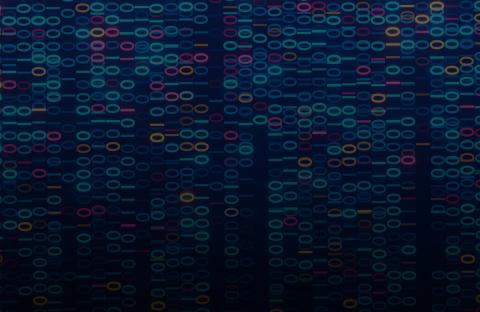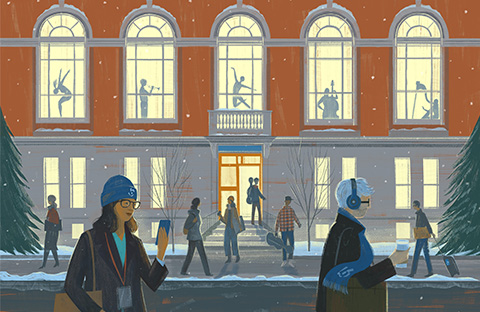Machine Learning

The debut of the large language model (LLM) chatbot ChatGPT and other AI tools in late 2022 marked a seismic shift that some predict will transform our daily lives at a scale comparable to the Industrial Revolution. For the performing arts and higher education specifically, generative AI presents a swarm of ethical and existential questions surrounding academic honesty, authorship, artistic compensation, and the future of creative enterprise.
STAGES talked with a cross section of faculty from the Dance, Music, and Theater divisions about how AI is impacting their fields and their teaching. While many have mixed feelings—including genuine concern about the potential disruptions and threats to creative livelihoods and to society at large—there is also a strong current of excitement about the possibility of expanding the artist’s tool set in powerful ways.
Confronting AI in Academic Writing

Kayla Gautereaux
Photo by Kelly Davidson
Voice faculty member Kayla Gautereaux teaches a series of courses within the M.F.A. in Musical Theater: Musical Theater Vocal Pedagogy program focused on thesis research, writing, and defense. Operating at the unique intersection of scientific writing and vocal arts, she guides graduate students through their thesis development, which involves asking an original research question on a topic that can range from the very scientific, such as biometric research on the biology of singing, to the more humanities based, such as the impact on one’s career of having a marginalized identity.
Gautereaux explains that there is no official consensus about how to confront AI in the field of scientific writing. “There is a recognition that students are going to use it, and there needs to be a conversation with someone informed to guide how to do so in a responsible way,” she says.
“There is a recognition that students are going to use it, and there needs to be a conversation with someone informed to guide how to do so in a responsible way.”—
In her thesis courses, Gautereaux places great emphasis on using AI responsibly, asking students to use it as a tool to “think critically about their own writing and about AI itself.” Editing workshops are a key component of her class, and she designates an AI editing day when students run their drafts through ChatGPT. “We analyze the results together and ask: How did AI change your writing structure and content? Are you going to implement these changes? How can you attribute the work accurately?” she says.
From Vocal Training to Training Voice Data Sets
In addition to incorporating ChatGPT into her teaching to aid students’ writing and research, Gautereaux also devotes class time to analyzing AI tools and emerging technologies specific to vocal training, such as the app Vocal Image, which promises to “unleash the full potential of your voice with guided vocal trainings, advanced AI analysis, and engaging vocal challenges.” She asks her students, who are studying to be voice teachers, “Would you give this to your students as a way to practice when you’re not in the room?”

Joy Arcolano
Photo by Kelly Davidson
Theater faculty member Joy Arcolano is also engaging her students in critical conversations about AI. As a professional voice actor who teaches a series of courses on voice-over acting—an industry undergoing a rapid disruption from emerging AI tools—she underscores in class discussions the consent and compensation concerns at the center of the recent prolonged SAG-AFTRA labor strikes.
AI has made it easier than ever to clone and auto-generate voices from an actor’s voice, leaving them vulnerable to developers who pilfer content without artists’ permission—and without providing compensation. Alarmingly, Arcolano says, the technology only needs a few recordings of her voice to train an AI model for generating future synthetic voice recordings, which can also be combined with other voice data to generate a ˮmultivoice.ˮ “Let’s say I do five recordings for a corporation and I don’t read my contract,” she explains. “They can take those five recordings and that is enough for them to train an AI in that consistent voice for the rest of time.”
In many cases, voice-over contracts stipulate that recordings are owned by the commissioning organization, not by the artist. Because of this, Arcolano devotes significant class time to deciphering contracts, imploring her students—some of whom have already worked as voice-over artists—to read their contracts closely and offering pointers on key clauses to look out for. Putting it bluntly, she says she teaches her students “how to read a contract so you know that they’re not going to be training, making a data set on the thing that you’re doing.”
“Let’s say I do five recordings for a corporation and I don’t read my contract. They can take those five recordings and that is enough for them to train an AI in that consistent voice for the rest of time.”—
Despite the very real disruptions and ethical issues posed by AI, Arcolano also acknowledges the benefits of AI tools, both current and potential. With some cautious optimism, she points to the emergence of AI voice-over services with built-in guardrails that give voice professionals agency over their recordings so “they will never use my voice to train a multivoice, but they will use my voice to create an AI voice that I can be an agent for.” As a busy artist, educator, and parent, the prospect of generating income from an AI version of her voice—literally while she sleeps—has obvious benefits, but the long-term outcomes of these relatively new models remain to be seen.
Technology in Motion

Jun Kuribayashi
Photo by Kelly Davidson
The same set of concerns surrounding compensation and copyright are at play in the world of dance. “There are companies out there that are scraping information without the dancers knowing it, and without giving compensation for it,” says dance faculty member Jun Kuribayashi. This is a major concern for dancers and choreographers alike, as movement data can provide valuable source material for a variety of entertainment, media, and tech industries.
On the other hand, Kuribayashi, who has served as a movement consultant for major feature films and television series (including CGI-based animation), also stresses that AI and other technologies are opening new doors for dance artists. In 2023, he cotaught the Dance Division’s Dance and Technology elective, which was launched in 2019 by dance faculty member Alissa Cardone and Berklee College of Music faculty member Lori Landay. The course immerses Boston Conservatory dancers in a range of emerging technologies to expand their artistry through digital experiences for the stage, screen, and beyond.
One area in particular that is opening new creative opportunities for dancers is the realm of motion capture—that is, live-action human movement used for computer-generated characters in movies, virtual and augmented reality experiences, video games, and more. A key challenge in motion-capture technology is replicating natural human movement in a variety of settings, which requires expensive technology and vast amounts of data and computer processing power to do well. It helps to have the input of humans with foundational training in movement. As Kuribayashi says, “when you’re a dancer, you’re a movement specialist. Dance departments across the country don’t actually talk about how you can have a career doing this.”
“When you’re a dancer, you’re a movement specialist. Dance departments across the country don’t actually talk about how you can have a career doing this.”—
“Dancers have this somatic intelligence,” Landay adds, “that’s something you don’t get in 10 minutes, that’s something you get in conservatory training.” As movement knowledge and body awareness are deeply embedded in dancers’ and choreographers’ expertise, Boston Conservatory dancers can apply their unique somatic skills while experimenting with new motion-capture technology to expand their creative toolbox—and career options.
Equipping Students with Powerful (Yet Fallible) Creative Tools

Lori Landay
Photo by Kelly Davidson
As part of the Dance and Technology course, Landay, a cultural studies professor with research interests in emerging technologies, made connections with MIT’s Immersion Lab, a cutting-edge research and technology facility just over a mile from the Conservatory campus. In fall 2023, Landay brought Boston Conservatory dancers to work with the lab’s state-of-the art depth cameras to record the dancers’ movements, which they placed on avatars. While acknowledging the ethical questions surrounding motion capture and its enablement of deep fakes on the internet, she believes that introducing students to these technologies is critical to preparing dance artists to be leaders in their fields. “We want to empower them to understand the technology,” she says. “Whether they are choreographers, producers, or directors, we want them to be making the most creative decisions that they want to make.”
“We want to empower [students] to understand the technology. Whether they are choreographers, producers, or directors, we want them to be making the most creative decisions that they want to make.”—

Paul Masters
Photo by Kelly Davidson
Paul Masters, who teaches courses in immersive and experiential theater in the Conservatory’s Theater Division, also notes that AI and extended-reality technology has great potential to open new opportunities for theater artists. With research interests in the technological aspects of theater—he is currently writing a book on immersive and experimental theater and large language models (LLMs)—Masters is excited about how technology can expand the possibilities of traditional live theater. “There’s a whole slew of opportunities outside the conventional theater, including digital performance, and those opportunities are going to increase over time,” he says. This includes experimental theater, where AI has been used as an immersive tool to create interactive experiences in which the audience participates in the action through chatbots and virtual reality.
“I want to make students aware that [these things] are tools—they are fallible tools and they replicate society’s implicit and explicit biases and myopic perspectives.”—
In the classroom, Masters has introduced students to LLMs such as ChatGPT and Bard as tools for initial research, guiding them on best practices for prompts. “I want to make students aware that [these things] are tools—they are fallible tools and they replicate society’s implicit and explicit biases and myopic perspectives,” he explains. For this reason, he says, it’s all the more important to bring LLMs into the curriculum.
Piano faculty member Aleksandr Polyakov also strongly believes that AI best practices must be integrated into coursework. “We must teach our students how it can be used—or else, for one, it creates unmeasurable inequality between students who know about these tools and students who don’t,” he says.

Aleksandr Polyakov
Photo by Kelly Davidson
Polyakov developed a guide that offers an overview of ways that music students can use chatbots to prepare for performances, improve their technique, and expand their understanding of the historical contexts of musical works. “I believe, if shown how, students can use AI tools as teacher assistants to their instructors, making information from lectures or from the book more relevant, applicable, and relatable to them,” he says. He also provides examples of effective prompts to generate the best results, such as “Can you tell me some background on how [insert composer] wrote their [piece]? What inspired them? List any facts, historical context, or other stories that can help with interpretation and performance of the piece.”
While Polyakov is concerned that chatbots can be misused by students in academic work, he acknowledges that, on the other hand, “it challenges us to be better educators rather than relying on assessment methods that have worked for decades.”
“I believe, if shown how, students can use AI tools as teacher assistants to their instructors, making information from lectures or from the book more relevant, applicable, and relatable to them.”—
While there are no cut-and-dried answers yet as to whether AI is a net positive or net negative force, the one certainty is that it cannot be ignored. “We have to learn how to integrate this technology into our practices, or it will have every possibility of overwhelming us,” Masters warns. “As artists, we can’t bury our heads in the sand on this one.”
READ: STAGES 2024

“Machine Learning” first appeared in the 2024 issue of STAGES, Boston Conservatory’s annual magazine.
